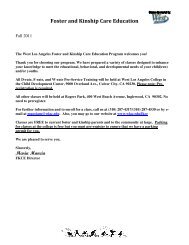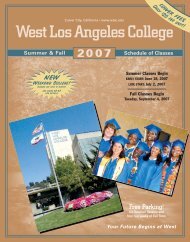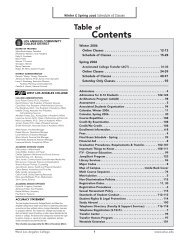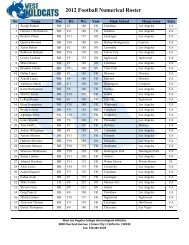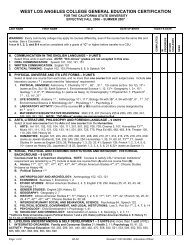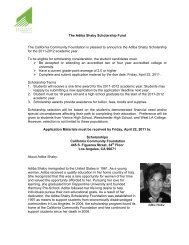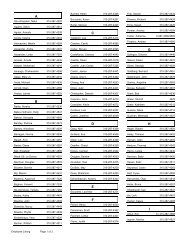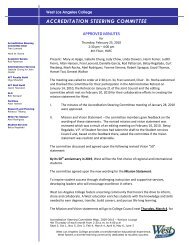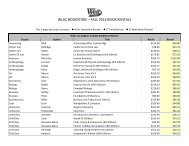Sample B
Sample B
Sample B
You also want an ePaper? Increase the reach of your titles
YUMPU automatically turns print PDFs into web optimized ePapers that Google loves.
“B” = Good paper, 40 to 45 points:<br />
The paper demonstrates strong writing ability. It is solid in content, organization, development,<br />
and style. The addresses important points and includes key events and dates. The essay contain<br />
minor flaws, but they are neither serious nor frequent. The writer exhibits clear control of<br />
language and general facility of diction, phrasing and sentence structure. Overall, the writing is<br />
solid.
Note: This paper got a 45 out of a possible 50 points<br />
This book report is on the novel Last Man Down: A New York City Fire Chief and the<br />
Collapse of the World Trade Center written by Richard Picciotto and Daniel Palsner. Richard<br />
Picciotto is re-telling his personal experience during the tragedy that occurred on September 11,<br />
2001 as a New York City Fire Chief. This may be the first book Picciotto has written, but is able<br />
to give the personal accounts what a Fire Chief went through on that tragic day. He is also able<br />
to include that hardships other city firefighters had to go through also as he came in contact with<br />
them the whole entire day and months after the collapse. He is one of the few qualified to write<br />
a novel about the pain and suffering hundreds of people had to go through that day, especially of<br />
those who were unfortunate to be buried under thousands of pound of mangled steel and<br />
concrete.<br />
I learned a lot of interesting things that went on that tragic day, but I’d have to say the<br />
most important thing that I learned from ready this book is the importance of leadership. Not<br />
just the importance of leadership within the fire department, but the ability to step up as a true<br />
leader and be able to take control of such a tragic situation that could have taken more lives than<br />
it did if it wasn’t for that true leadership. I found this very interesting because it’s amazing how<br />
a single person can just take control and plan out a well orchestrated evacuation plan that in<br />
return save the lives of many of those that were in the North Tower than unfortunate day. I’d<br />
have to say it was kind of hard to stay interested as far as the style the novel was written, but I<br />
really wanted to find out how he and the other firefighters with him survived the collapse. It was<br />
more of an interest for the facts than the actual story telling. The following is my report on the<br />
novel Last Man Down: A New York City Fire Chief and the Collapse of the World Trade Center<br />
by Richard Picciotto and Daniel Palsner. Published by The Berkley Publishing Group in New<br />
York, New York in 2002. The novel re-tells Chief Piciotto’s experiences on September 11,<br />
2001 and I will be outlining what I think were the most important parts of the book chapter by<br />
chapter.<br />
Chapter 1<br />
Chapter one begins with Chief Richard Piccioto giving a brief description of the day this<br />
whole novel is about, September 11, 2001. There was no other way to put it other that it was a<br />
beautiful day that killed us as it was a clear day with a high sun and a visibility that went forever.<br />
He lived in Chester, New York with his wife Debbie, son Stephen and daughter Lisa. His wife<br />
was an obstetrical nurse at St. Luke’s Hospital; his son went to a private Catholic high school in<br />
New Jersey while his daughter was a senior at Pace University in lower Manhattan. Chief<br />
Piccioto arrived to work that day as Battalion Chief 11 of 7 companies in New York at around 8<br />
o’clock in the morning. He looked over Engine Co. 37, Ladder Co. 40, Engine Co. 47, Engine<br />
Co. 74, Ladder Co. 25, Engine Co. 76, and Ladder Co. 22. At about quarter to 9 his station<br />
received a call from the intercom telling them to turn on their television to channel 7 to see that<br />
the North Tower of the World Trade Center had been hit by an airplane. Chief Picciotto<br />
immediately calls dispatch and informs them about his experience of the attempt in 1993 and that<br />
he was ready to go assist, but dispatch tells him to stay put. A little while later they see on the<br />
television that the South Tower also got hit by another airplane so he once again calls dispatch<br />
this time with success as he is given the okay to go assist.
Chapter 2<br />
Chief Picciotto then teams up with who he thinks is one of the best engineers he’s known<br />
Gary Sheridon to drive him down to the North Tower. The other firefighters want to join the<br />
Chief, but protocol says that they can’t join until they get called out in an alarm. On the way to<br />
the tower they Chief tried to think like a terrorist and figure out what other place can be attacked<br />
such as the George Washington Bridge and the Brooklyn tunnels. When they arrived they pulled<br />
up on West Street catty-corner of the World Trade Center which coincidentally was the same<br />
place he parked during the attack of 1993. The Chief grabbed a flashlight and bullhorn and ran<br />
into the North Tower as he dodged the bodies of people who had desperately jumped from the<br />
tower in desperation. Sadly enough the first firefighter to die that day was Lieutenant Danny<br />
Suhr of Engine 216 as he was struck by falling women. Once inside the tower, the Chief<br />
grabbed Truck Co. 110 from the command post within the tower and headed up to floors 21 and<br />
25 as they were told there were people trapped on those floors.<br />
Chapter 3<br />
This chapter begins with the layout of the stairwells in both the South and North towers.<br />
They each had 3 stairwells that were located in a “T” formation. Stairwell A was at the southeast<br />
corner of the North Tower while stairwell C was at the southwest corner. Stairwell B was in the<br />
center of the tower. Both A and C went as low as the mezzanine level where they connected<br />
with stairwell B that lead down to the lobby. Chief decided to take the elevator because the guys<br />
from truck 110 had all of their gear which added an extra 70 to 100 pounds despite the warning<br />
from fellow Battalion Chief John Paolillo. They took the elevator to the 16 th floor and walked<br />
the rest of the way to the 21 st floor through stairwell C. When they reached the 21 st floor it was<br />
already clear so they continued to the 25 th floor. When they arrived there was already another<br />
firefighter crew clearing out the floor. Chief Picciotto then decided to head up higher on his own<br />
because he wasn’t carrying any gear so he told the lieutenant from truck 110 that he would meet<br />
them up on the fire floor. When he reached the 35 th floor he noticed that it was a staging area for<br />
rescue workers so he went in to see what was going on.<br />
Chapter 4<br />
While on the 35 th floor there was an unexplainable thunder outside that shook everybody<br />
up. Chief Picciotto got a radio transmitting that the South tower had collapsed. He then had to<br />
make crucial decision whether to fight or flight, but he had to think about the other firefighters<br />
with him on the floor so he called out for an immediate evacuation of the North tower. The<br />
Chief made himself the tail end of the evacuation as he performed a plan search of every floor as<br />
he started at stairwell C and went across to A then went to B where he doubled back and went<br />
down stairwell C. When they reached the 31 st floor a port authority that was in the group had<br />
taken into custody a Middle Eastern guy in a nice suit because he seemed suspicious. He was the<br />
only civilian on the higher floors long after the airplane had hit the tower. As they made it down<br />
to the 27 th floor Chief Picciotto saw a guy still typing away at his computer like normal. The<br />
Chief then shouted to the guy to evacuate immediately, but after the guy ignored the orders he<br />
ran in a forced the guy out of the room and into the staircase with everyone else.<br />
Chapter 5<br />
All of those evacuating came to an abrupt stop at the 16 th floor due to debris blocking the<br />
stairwell. The Chief ran over to stairwell A, but it was also full with debris so they had to go<br />
down stairwell B. They then noticed a room on the 12 th floor that was full of civilians. There<br />
were about 60 of them waiting to get escorted as they were all either too tired to continue or they<br />
had some sort of disability. The Chief remembers Josephine Harris a 59 year old grandmother
from Brooklyn being the last one out of the room because she set the pace for him and Ladder<br />
Co. 6<br />
Chapter 6<br />
As the Chief made his way down to the lower floors there was another loud sound almost<br />
like the one he heard when the South tower collapsed. He described it as being caught in an<br />
avalanche during a hellish tornado while trapped in a wind tunnel all beneath a crashing tsunami<br />
with no hope of escape. The Chief quickly realized what the sound meant and began to run<br />
down the staircase to catch up the rest of the firefighters. The rumbling caused him to pause on a<br />
landing between the 6 th and 7 th floor where he was struck by a blunt object on the head knocking<br />
his helmet off. He tried getting back up, but the landing gave way and began to fall with him on<br />
top of it. When the landing finally stopped he though he was dead because he was still very<br />
weary, but he came to his senses and realized he was fine with no major injuries trapped in a<br />
void space under debris. He yelled out to see if anyone could hear him, but there was no<br />
response.<br />
Chapter 7<br />
Just as the Chief thought he was all alone he yelled out again and got a response from<br />
several people around him. When he realized they were fellow firefighters he began a roll call.<br />
It consisted of Mickey Kross, Lieutenant of Co. 16, Jim Mcglynn , Lieutenant of Co. 39, Jay<br />
Jonas, Captain of Co. 6 along with firefighters: Rob Bacon, Jeff Coniglio, Jim Efthimiaddes, Bill<br />
Buttler, Tom Falco, Mike Meldrum, Sal D’Agostino and Matt Komorowski. Josephine Harris<br />
was also trapped with Jay Jonas and crew. David Lim a Port Authority was trapped below him.<br />
The last voice to call in was that of Battalion Chief Richard Prunty over the radio, he had the<br />
most serious of the injuries as he fell further down than everyone else. Chief Picciotto realized<br />
he had fallen about 40 feet as he could see the number 2 on the wall indicating they were on the<br />
second floor. He, Jim McGlynn and Rob Bacon tried breaking into the door on the second floor,<br />
but the office space was full of debris. Chief Picciotto writes that he later found out that Jay<br />
Jonas made contact with Deputy Nick Visconti who was in charge of a command on West and<br />
Vesey streets while they were trapped and tried to come up with a rescue plan.<br />
Chapter 8<br />
While being trapped the Chief began making mayday calls over the radio when he was<br />
finally answered by Mark Ferran a Chief out of Battalion 12. He had gone to help out in<br />
whatever he could being that it was his day off. The Chief informed Mark that he along with<br />
other firefighters were trapped in stairwell B of the North Tower. Mark teamed up with Ladder<br />
Co. 43 to try and find the stairwell, but there was no possible way any of them knowing where it<br />
was due to the amount of debris in the city. Matt Long, John Colon, Jerry Sunden, Todd<br />
Frederickson, Mike Regan, Frank Macchia, Jim Lanza, Tom Corrigan and Mark Ferran all tried<br />
finding out where the stairwell was, but they had no idea. They then ran into another firefighter<br />
from Truck Co. 18 who had an idea where it was. He lead them into a Borders bookstore on the<br />
corner of Vesey and Church which was suppose to lead them to an escalator up top the main<br />
plaza of the World Trade Center. When they arrive where the escalator was suppose to be all<br />
they saw was a giant hole. All Mark could do then was get on the radio and tell the Chief that<br />
they still cant find a way to them, but that they were coming.<br />
Chapter 9<br />
In this chapter Chief Picciotto tells us that he use to be police officer before being a<br />
firefighter. He was on the force for 2 years, but got laid off due to a financial freeze. That’s<br />
when he realized he wanted to be a firefighter. While being trapped under the rubble Port
Authority David Lim shouted that he was being soaked by jet fuel, but no one else could smell or<br />
feel it, but it still raised some concern between them. Chief Picciotto then noticed a small light<br />
appearing above them and it became larger. He realized that as the smoke began to settle, it had<br />
made way to the sunlight to shine through a hole that was there the whole time. The first thing<br />
he does is he gets on the radio and tells Mark that he can see a hole above them now, but still has<br />
no directional sense of where he is at.<br />
Chapter 10<br />
Now with more visibility of the whole Chief Picciotto decides to get to the hole. He<br />
makes a stop where Jay Jonas is trapped and he tells the Chief that there is an elevator shaft they<br />
can go down on, but the Chief continues his way up to the hole. When the Chief finally made it<br />
out he realized the he was still on high unstable ground far away from safety. He gets on the<br />
radio and tells Mark that he has made it out of the debris and sounds the bullhorn to see if Mark<br />
can hear it. Mark replies that he could hear it, but that it was still close to impossible to get to<br />
them. Mike Meldrum, Sal D’Agostino, Tom Falco, Matt Komorowski, Bill Buttler, David Lim,<br />
Mickey Kross and Jay Jonas followed the Chief to the hole. They then used a cell phone Bill<br />
Buttler had to call their family and let them know they were okay. The Chief didn’t want to<br />
worry his wife so he tried calling other fire departments instead, but couldn’t get through.<br />
Chapter 11<br />
The Chief and the other guys got tired of waiting for help so they planed a way to get to<br />
safety. That’s when they see a helmet in the distance and they use the bullhorn to get the<br />
person’s attention. It turned out to be Mark and the crew from Ladder Co. 43. The Chief<br />
decided to wait a little longer to see if they would arrive, but they couldn’t get past the debris so<br />
he began in journey down to safety. Half way through the debris the Chief noticed that the crew<br />
from Ladder 43 had finally reached the hole to help the other firefighters still trapped in the<br />
collapse. He finally made it out of the rubble by the old Vista Hotel on West street to find more<br />
firefighters just standing around. The Chief tried telling a staff chief that there were more<br />
firefighters trapped, but the staff chief told him that the department wasn’t sending out anymore<br />
men. Word got out to the volunteer fire department by Chief Picciotto’s house that he was okay<br />
and they went to his house to inform the family. The only one there to receive the good new was<br />
his son Stephen. Chief Picciotto was finally able to get a crew led by Battalion Chief John Salka<br />
to go and help the firefighters that were still trapped. He stayed on the radio a while to help with<br />
the rescue, but he was eventually taken to St. Vincent’s Hospital for treatment. Everyone<br />
involved in the collapse of stairwell B was able to get to safety under their own power after<br />
getting rescued except for Josephine Harris who was taken out in a Stokes basket and Battalion<br />
Chief Richard Prunty who was found dead. While in the hospital the Chief finally got a hold of<br />
his wife around 8 in the evening. During the conversation he told her that he was done. That he<br />
wasn’t going back to work. He finished the book by saying that he might have told his wife he<br />
was done, but he wasn’t done yet. He was still the Chief and he had widows to call and brothers<br />
to comfort.<br />
The story itself was a very interesting story, but the way it was written was very cut dry.<br />
There wasn’t much emotion or drama that could have been included with a story like this. I<br />
think it might have the fact that it was written by a firefighter, but even though he went through<br />
all this himself. It just seems like a lot was left out that could have made the novel much better.<br />
He kept saying that there want much conversation while they all trapped under the rubble and<br />
that no one showed any emotions. I don’t know if this is truth or he just said that to make the
firefighters along with himself seem brave and heroic. I’m sure there a lot of those guy’s<br />
emotions were all over the place. I mean they were still alive after the collapse of a 110 story<br />
building, there had to be more than what was written. The ending of the novel was also pretty<br />
dry. It he just states that everyone made it out okay and that they went to the hospital. I’m sure<br />
there was a lot more that occurred from the time they began finding their way to safety till the<br />
time they were taken to the hospital. The novel lacked the emotional sense that would have<br />
turned into one of just interesting facts to one that could have been very touching to those who<br />
read it.<br />
The one good thing about the book was all the informational facts and events that were<br />
presented during the novel. It gave the reader a sense of what actually happened on that tragic<br />
day. It also showed the hardships that many firefighters along with the city’s residence had to go<br />
through. I didn’t know that the rubble had fallen so far from the actual site of the two towers<br />
causing the rescue missions to be so difficult. This was one of the major difficulties Mark and<br />
the guys from Ladder 43 had. They just couldn’t determine which part of the debris was part of<br />
the North Tower let alone where stairwell B was. It brought closer to the reality of that dreaded<br />
day.<br />
Id like to conclude by stating that it was an overall good book in regards to the author<br />
trying to get his story out, but it could have used more of the emotional factor. IIt was kind of<br />
like reading an incident report he might have written with all the facts. I probably won’t read<br />
this book again just because I already got the facts from it and it didn’t get my attention as far as<br />
the flow. I would recommend it, but only as an informational book and not as leisurely read. I<br />
guess in the end it would be extremely difficult to try and sugar coat this story seeing its severity.<br />
I did love the way it portrayed the true actions of leadership and how with strength and total<br />
determination a leader and overcome any obstacle put in the way. I would like to commend<br />
Chief Richard Picciotto for being able to put his near death experience into a book. It would be<br />
extremely hard for most people to relive something he went through.





